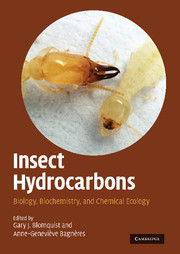Book contents
- Frontmatter
- Contents
- List of contributors
- Foreword
- Acknowledgments
- Part I Chemistry, Biochemistry, and Physiology
- Part II Chemical Communication
- 10 Perception and olfaction of cuticular compounds
- 11 Nestmate recognition in social insects and the role of hydrocarbons
- 12 Cuticular hydrocarbon cues in the formation and maintenance of insect social groups
- 13 Hydrocarbon profiles indicate fertility and dominance status in ant, bee, and wasp colonies
- 14 Chemical deception/mimicry using cuticular hydrocarbons
- 15 Behavioral and evolutionary roles of cuticular hydrocarbons in Diptera
- 16 Contact recognition pheromones in spiders and scorpions
- 17 Hydrocarbons as contact pheromones of longhorned beetles (Coleoptera: Cerambycidae)
- 18 Polyene hydrocarbons, epoxides, and related compounds as components of lepidopteran pheromone blends
- 19 Volatile hydrocarbon pheromones from beetles
- 20 Future directions in hydrocarbon research
- Index
11 - Nestmate recognition in social insects and the role of hydrocarbons
from Part II - Chemical Communication
Published online by Cambridge University Press: 18 May 2010
- Frontmatter
- Contents
- List of contributors
- Foreword
- Acknowledgments
- Part I Chemistry, Biochemistry, and Physiology
- Part II Chemical Communication
- 10 Perception and olfaction of cuticular compounds
- 11 Nestmate recognition in social insects and the role of hydrocarbons
- 12 Cuticular hydrocarbon cues in the formation and maintenance of insect social groups
- 13 Hydrocarbon profiles indicate fertility and dominance status in ant, bee, and wasp colonies
- 14 Chemical deception/mimicry using cuticular hydrocarbons
- 15 Behavioral and evolutionary roles of cuticular hydrocarbons in Diptera
- 16 Contact recognition pheromones in spiders and scorpions
- 17 Hydrocarbons as contact pheromones of longhorned beetles (Coleoptera: Cerambycidae)
- 18 Polyene hydrocarbons, epoxides, and related compounds as components of lepidopteran pheromone blends
- 19 Volatile hydrocarbon pheromones from beetles
- 20 Future directions in hydrocarbon research
- Index
Summary
One of the conditions favoring the evolution and maintenance of sociality is the ability to discriminate between kin and non-kin, because it allows altruistic acts to be directed to recipients of high relatedness (Hamilton, 1987). Nestmate recognition is the process whereby social insects recognize individuals belonging to their own colony or an alien colony, and accordingly allow or prohibit entry to their nest. Nestmate recognition often results in the discrimination of kin from non-kin, but in social insects there is a distinction to be made between nestmate and kin recognition. Where kin recognition is the assessment of the degree of relatedness towards another individual, nestmate recognition is the binary recognition of group membership (Arnold et al., 1996; Lenoir et al., 1999). In ants, wasps and termites, the blend of hydrocarbons present on the cuticle appears to comprise the essential compounds that serve as nestmate recognition cues (Howard and Blomquist, 2005), although in honeybees fatty acids and esters may also play an important role (Breed, 1998a; but see Dani et al., 2005; Ch?ine et al., 2005). At the end of the 1990s, the notion that cuticular hydrocarbons act as recognition cues was supported mainly by correlative evidence (Singer, 1998; Vander Meer and Morel, 1998; Lenoir et al., 1999), but significant progress has been made over the last decade.
- Type
- Chapter
- Information
- Insect HydrocarbonsBiology, Biochemistry, and Chemical Ecology, pp. 222 - 243Publisher: Cambridge University PressPrint publication year: 2010
- 264
- Cited by



